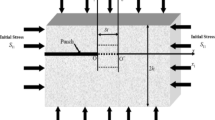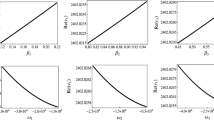Abstract
The effect of stress on wave propagation in fluid-saturated porous thermoelastic media is poorly understood. To fill this gap, we propose the dynamical equations for stressed fluid-saturated porous thermoelastic media based on the poroacoustoelasticity model and porothermoelasticity model to describe the effect of stress on the wave dispersion and attenuation. A plane-wave analysis for dynamical equations formulates stress-dependent velocities of five wave propagation modes, including three longitudinal (P) waves, namely fast P wave, slow P wave and thermal (T) wave, and two shear (S) waves, namely fast S wave and slow S wave. Additional slow P wave and T wave arise due to the Biot and thermal loss mechanisms in porothermoelastic media. The stress-induced rock anisotropy accounts for the S wave splitting phenomenon. Modelling results show that energy dissipations of fast P wave and T wave are induced by the coupling between Biot and thermal loss mechanisms, while the fast and slow S waves, slow P wave are only affected by Biot loss mechanism. The rock permeability and fluid viscosity are mainly related to Biot mechanism, while the thermal conductivity and thermal expansion coefficient for solid phase are related to Biot and thermal mechanisms. In addition, the triaxial stress and confining stress have remarkable effects on the wave velocities as well as attenuation peaks. The predicted wave velocities in water-saturated sandstone and granite behave a reasonable agreement with the laboratory measurements. Our results help to provide better understanding of wave propagation in high-stress high-temperature fields.
Article Highlights
-
We propose the dynamical equations for fluid-saturated porous thermoelastic media with the effect of stress.
-
Our model predicts five wave propagation modes, namely fast P wave, slow P wave, thermal wave, fast S wave and slow S wave.
-
Biot and Thermal loss mechanisms are coupled to describe the stress-dependent dispersions and attenuations for these five wave modes.
























Similar content being viewed by others

Data Availability
Data and code associated with this research are available and can be obtained by contacting the corresponding author.
References
Armstrong BH (1984) Models for thermoelastic in heterogeneous solids attenuation of waves. Geophysics 49(7):1032–1040
Ba J, Carcione JM, Cao H, Yao HZ, Du QZ (2013) Poro-acoustoelasticity of fluid-saturated rocks. Geophys Prospect 61(3):599–612
Batzle M, Wang ZJ (1992) Seismic properties of pore fluids. Geophysics 57(11):1396–1408
Berezovski A, Maugin GA (2001) Simulation of thermoelastic wave propagation by means of a composite wave-propagation algorithm. J Comput Phys 168(1):249–264
BudianskySumner BEE, Oćonnell RJ (1983) Bulk thermoelastic attenuation of composite materials. J Geophys Res: Solid Earth 88(B12):10343–10348
Biot MA (1956) Theory of propagation of elastic waves in a fluid-saturated porous solid. I. low-frequency range. J Acoust Soc Am 28(2):168–178
Biot MA (1956b) Thermoelasticity and irreversible thermodynamics. J Appl Phys 27(3):240–253
Biot MA (1962) Mechanics of deformation and acoustic propagation in porous media. J Appl Phys 33(4):1482–1498
Carcione JM (2014) Wave fields in real media. theory and numerical simulation of wave propagation in anisotropic, anelastic, porous and electromagnetic media. Elsevier
Carcione JM, Cavallini F, Wang E, Ba J, Fu LY (2019) Physics and simulation of wave propagation in linear thermoporoelastic media. J Geophys Res: Solid Earth 124:8147–8166
Carcione JM, Gei D, Santos JE, Fu LY, Ba J (2020) Canonical analytical solutions of wave-induced thermoelastic attenuation. Geophys J Int 221:835–842
Chandrasekharaiah DS (1986) Thermoelasticity with second sound: a review. Appl Mech Rev 39(3):355–376
Chen FB, Zong ZY, Jiang M (2021) Seismic reflectivity and transmissivity parameterization with the effect of normal in-situ stress. Geophys J Int 226(3):1599–1614
Chen FB, Zong ZY, Yin XY, Feng YW (2022a) Accurate formulae for P-wave reflectivity and transmissivity for a non-welded contact interface with the effect of in situ vertical stress. Geophys J Int 229(1):311–327
Chen FB, Zong ZY, Yin XY (2022) Acoustothermoelasticity for joint effects of stress and thermal fields on wave dispersion and attenuation. J Geophys Res-Solid Earth 25:871
Cheng W, Ning FL, Sun JX, Liu ZC, Jiang GS, Li XD (2019) A porothermoelastic wellbore stability model for riserless drilling through gas hydrate-bearing sediments in the Shenhu area of the South China Sea. J Nat Gas Sci Eng 72:103036
Cheng AHD (2015) Poroelasticity. Springer Press
David E, Zimmerman RW (2012) Pore structure model for elastic wave velocities in fluid-saturated sandstones. J Geophys Res: Solid Earth 117:B07210
Fu BY, Fu LY (2017) Poro-acoustoelastic constants based on Padé approximation. J Acoust Soc Am 142(5):2890–2904
Fu BY, Fu LY (2018) Poro-acoustoelasticity with compliant pores for fluid-saturated rocks. Geophysics 83(3):1–14
Green AE, Lindsay KE (1972) Thermoelasticity. J Elast 2(1):1–7
Grinfeld MA, Norris AN (1996) Acoustoelasticity theory and applications for fluid-saturated porous media. J Acoust Soc Am 100(3):1368–1374
Guo JX, Gurevich B (2020) Effects of coupling between wave-induced fluid flow and elastic scattering on P-wave dispersion and attenuation in rocks with aligned fractures. J Geophys Res: Solid Earth 125(3):18685
Guo JX, Gurevich B (2020) Frequency-dependent P wave anisotropy due to wave-induced fluid flow and elastic scattering in a fluid-saturated porous medium with aligned fractures. J Geophys Res: Solid Earth 125(8):20320
Ignaczak J, Ostoja-Starzewski M (2010) Thermoelasticity with fnite wave speeds. Oxford University Press
Kern H, Popp T, Schmidt R (1993) The effect of a deviatoric stress on physical rock properties. Surv Geophys 15:467–479
Korneev V, Glubokovskikh S (2013) Seismic velocity changes caused by an overburden stress. Geophysics 78(5):25–31
Liu JX, Cui ZW, Sevostianov I (2021) Effect of stresses on wave propagation in fluid-saturated porous media. Int J Eng Sci 167:103519
Long MD, Silver PG (2009) Shear wave splitting and mantle anisotropy: measurements, interpretations, and new directions. Surv Geophys 30:407–461
Lord H, Shulman Y (1967) A generalized dynamical theory of thermoelasticity. J Mech Phys Solids 15(5):299–309
Mavko G, Mukerji T, Godfrey N (1995) Predicting stress-induced velocity anisotropy in rocks. Geophysics 60(4):1081–1087
Nield DA, Bejan A (2006) Convection in porous media. Springer Press
Noda N (1990) Thermal stress problem in a fluid-filled porous circular cylinder. Zeitschrift Fur Angewandte Mathematik Und Mechanik 70:543–549
Poletto F, Farina B, Carcione JM (2018) Sensitivity of seismic properties to temperature variations in a geothermal reservoir. Geothermics 76:149–163
Povstenko Y (2015) Fractional thermoelasticity. Springer Press
Prioul R, Bakulin A, Bakulin V (2004) Nonlinear rock physics model for estimation of 3D subsurface stress in anisotropic formations. Geophysics 69:415–425
Qu YL, Liu JX, Cui ZW, Lv WG (2018). Third-order elastic moduli of the dry and water saturated rocks. Proceedings of the International Workshop on Environment and Geoscience–IWEG, 1: 428–433.
Rasolofosaon P (1998) Stress–induced seismic anisotropic revisited. Revue de l’Institut Francais du Petrole 53:679–692
Rawal C, Ghassemi A (2014) A reactive thermo-poroelastic analysis of water injection into an enhanced geothermal reservoir. Geothermics 50:10–23
Sevostianov I, Trofimov A, Merodio J, Penta R, Rodriguez-Ramos R (2017) Connection between electrical conductivity and diffusion coefficient of a conductive porous material filled with electrolyte. Int J Eng Sci 121:108–117
Sharma MD (2008) Wave propagation in thermoelastic saturated porous medium. J Earth Syst Sci 117:951–958
Sun Y, Gurevich B (2020) Modeling the effect of pressure on the moduli dispersion in fluid-saturated rocks. J Geophys Res: Solid Earth 125:19297
Wang EJ, Carcione JM, Cavallini F, Botelho M, Ba J (2021) Generalized thermo-poroelasticity equations and wave simulation. Surv Geophys 42:133–157
Winkler KW, McGowan L (2004) Nonlinear acoustoelastic constants of dry and saturated rocks. J Geophys Res: Solid Earth 109:B10204
Youssef HM (2007) Theory of generalized porothermoelasticity. Int J Rock Mech Min Sci 44(2):222–227
Zimmerman RW, Somerton WH, King MS (1986) Compressibility of porous rocks. J Geophys Res 91(12):765–777
Acknowledgements
The authors cordially thank the Editor in Chief, Michael J. Rycroft, and two anonymous reviewers for their constructive suggestions and comments that significantly help improve our work and also acknowledge the sponsorship of National Natural Science Foundation of China (42174139, 41974119, 42030103), Marine S&T Fund of Shandong Province for Pilot National Laboratory for Marine Science and Technology (Qingdao) (2021QNLM020001-6) and Science Foundation from Innovation and Technology Support Program for Young Scientists in Colleges of Shandong Province and Ministry of Science and Technology of China (2019RA2136). The data supporting Table 1 and Table 2 in this paper are available.
Author information
Authors and Affiliations
Corresponding author
Additional information
Publisher's Note
Springer Nature remains neutral with regard to jurisdictional claims in published maps and institutional affiliations.
Appendices
Appendix A: Stress- and temperature-dependent coefficients
From Eqs. 17 and 18, for the case that the directions of applied stress coincide the principle coordinate axes, and the wave propagates along axis \(X_{3}\), the coefficients in Eq. 37 can be given by
The initial strain tensors for fluid phase and solid phase \(e_{ij}^{s}\) and \(\zeta^{s}\) can be computed with Eqs. 19 and 20, which comprehensively reflect the magnitudes of applied stresses.
Appendix B: Stress- and temperature-dependent fluid properties
We model the stress- and temperature-dependent fluid (water) properties, such as density, velocity and viscosity, with the BW model (Batzle and Wang 1992). The water density is given by
where \(\rho_{w}\) is water density in g/cm3 at normal pressure and temperature (15.6 °C and atmospheric pressure). \(p_{f}\) is pore pressure. \(\theta_{t}\) is centigrade temperature and \(\theta_{t} = \theta - 273\) where \(\theta\) is the corresponding absolute temperature.
The P-wave velocity in the water is
where constant matrix \(w_{ij}\) is given in Table 1 in Batzle and Wang (1992).
For the case of temperature below 250 ℃, the water viscosity can be approximated by
where \(x\) is the weight fraction (ppm) of sodium chloride.
With Eqs. 56–58, the stress- and temperature-dependent density, P-wave velocity and viscosity of water can be computed, and with these properties, the bulk modulus of fluid can be further obtained.
Moreover, detailed laboratory and theoretical studies on the stress and temperature dependences of oil and gas properties can be found in Batzle and Wang (1992).
Rights and permissions
Springer Nature or its licensor (e.g. a society or other partner) holds exclusive rights to this article under a publishing agreement with the author(s) or other rightsholder(s); author self-archiving of the accepted manuscript version of this article is solely governed by the terms of such publishing agreement and applicable law.
About this article
Cite this article
Zong, Z., Chen, F., Yin, X. et al. Effect of Stress on Wave Propagation in Fluid-Saturated Porous Thermoelastic Media. Surv Geophys 44, 425–462 (2023). https://doi.org/10.1007/s10712-022-09743-y
Received:
Accepted:
Published:
Issue Date:
DOI: https://doi.org/10.1007/s10712-022-09743-y



